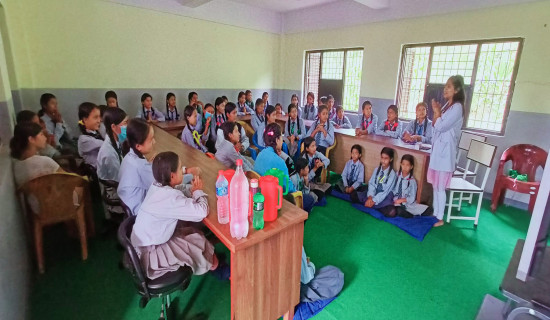- Tuesday, 23 April 2024
Utilising Remittances For Development
Nepal has been identified as one of the highest remittance recipient nations in the world. Remittance flows into low- and middle-income countries are on a continuous rise, a trend observed in Nepal as well. Remittances have become a major contributing factor to increasing household income as well as the country’s gross domestic product (GDP). More than 30 per cent of Nepal’s GDP comes in the form of remittance. It helps reduce poverty. Remittances annually amount to 20 per cent internally, 11 per cent from India, and 69 per cent from Gulf countries. Almost 79 per cent of remittance is used for meeting daily needs and the remaining for miscellaneous purposes.
The Department of Foreign Employment (DoFE) has issued over four million labour permits to Nepali workers from 2009 to 2019. Out of 110 destination countries for labour migration, Qatar, the United Arab Emirates (UAE), Saudi Arabia, Kuwait, and Malaysia are the top five. In the last two decades, remittance has emerged as the backbone of Nepal's economy. According to the World Bank (WB), remittance is now considered equally important as foreign direct investment, official development assistance and international trade for development activities because the amounts of remittance flowing to the Least and Middle-Income Countries (LMICs) are more than three times the size of official development assistance and higher than that of foreign direct investment.
Problems
As a main source of national income, remittances have significantly contributed to the economy of Nepal by raising the living standards of the people. However, they are overshadowed by the tragedies associated with it. Nepali migrant labourers are facing high risks. They have become victims to forced labour, trafficking, sexual abuse and physical harassment, debt bondage, nonpayment of wage and discriminating laws and policies in destination countries. The main problem of remittances can be cited as the migration process in the home country is disconnected to that of destination countries. Almost all labourers are cheated by the employment agents of both the emigrant and immigrant countries. Labourers suffer from exploitation and deprivation from basic facilities like medical services and insurances, let alone recreational facilities. Exploitations begin even before their departure by recruitment agencies and their sub-agents. In some cases, women workers are more vulnerable to exploitation by employers. Female workers need to be prepared for abuse and sexual harassment, especially for those who are employed as domestic helpers.
Given the huge influx of remittances, many problems, complexities, and challenges have plunged Nepali society into an extreme low. As Nepalis enter the external labour market, imports are increasing and exports are declining, resulting in huge trade deficit year after year. The increase in inflows of remittances decreases agro-product, increases consumption, and does not change investment, leading to deteriorating GDP per capita. Therefore, remittances are an obstacle to economic growth. Remittances can reduce labour supply and create a culture of dependency that inhibits economic growth. A better understanding of their impacts is needed in order to formulate specific policy measures that will enable developing economies to get the greatest benefit from these monetary inflows.
Labour migration for foreign employment of Nepal has been increasing rapidly for the past two decades. Recently, it is estimated that about half of the households in Nepal have at least one member abroad or have a returnee of foreign employment. The present situation of labour migration from Nepal is largely due to the lack of employment in the country. Moreover, increasing trends of labour migration placed Nepal as the high remittance recipient country among the least developed countries. Therefore, depending on foreign employment remittance plays a significant role in the growing nation’s GDP. But foreign employment is not a permanent solution to the country’s unemployment problems. The analysis of poverty reduction in Nepal is dependent upon the income generation aspect with respect to the indicators of human development and overall social economic activities. According to the Nepal Living Standard Survey (NLSS), poverty has been reduced from 42 in 1996 to 17 per cent in 2021. So remittance has significantly contributed to the economic development of the country and raised the living standard of the people with the help of foreign employment and remittance income.
Need of new policies
In this context, the government should ensure the required protection for labourers from exploitation by improving rules and regulations. The government should also formulate an appropriate foreign employment policy for Nepali labourers so that they can be diversified to several countries having high employment potentialities with high remunerations. About two per cent of total remittance inflows into Nepal contribute to capital formation. The utilisation of remittance in the productive sector enhances the output and consequently aids in further reduction in poverty. To align remittances in productive activities such as self-employment, financial investment, etc., remittance-focused policy is advised to reach out to recipients and provide them rigorous advisory and training support. Therefore, developing new policies can advance the sustainable socio-economic development of the nation.
(Mainali is a former Labour Secretary of Nepal government.)















